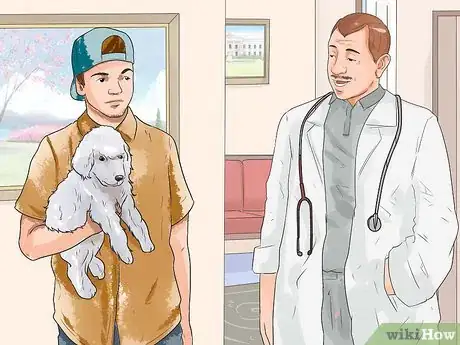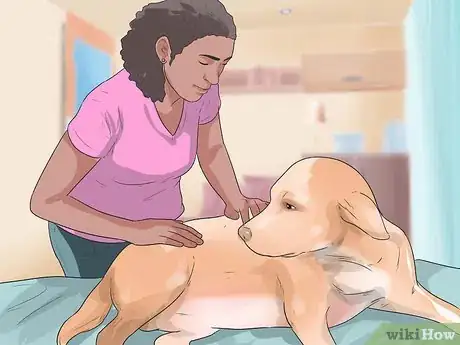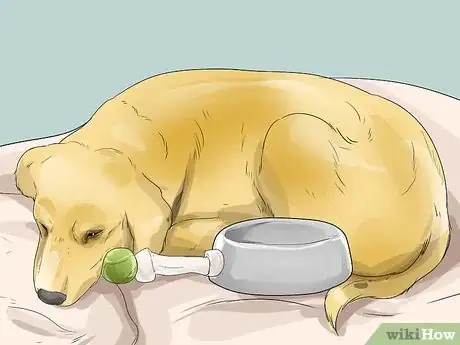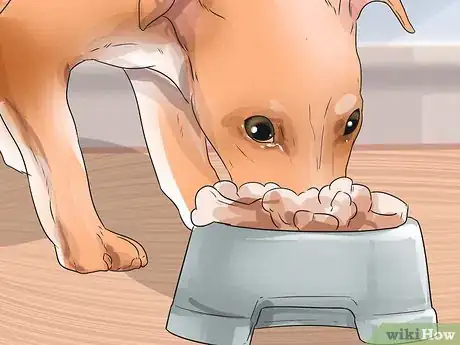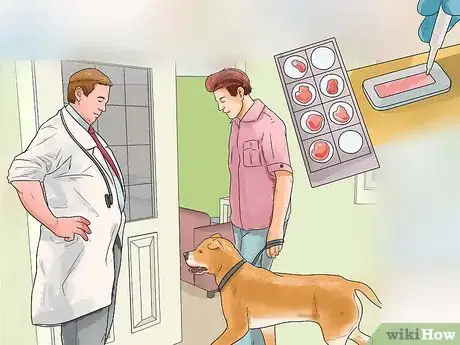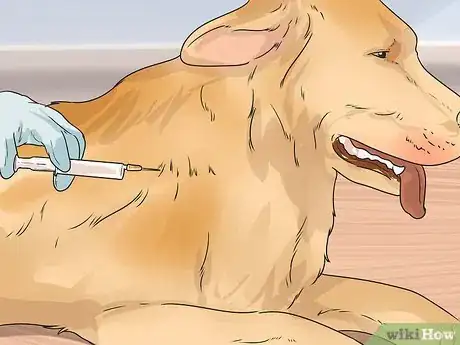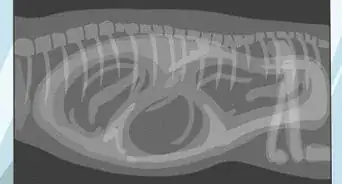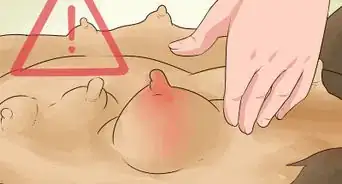This article was co-authored by Jeannie McElroy. Jeannie McElroy is a Canine Enthusiast & Breeder of Champion European Boxers under the kennel name Big Mac Boxers. With over 25 years of experience, she specializes in training, working, showing, and titling her dogs in many different types of ring sports. Jeannie is an AKC Evaluator and titles therapy dogs for Therapy Pets Unlimited. She is also a member of the AKC Bred with Heart, Greater Cincinnati Boxer Club, and US-BOX Working Boxer Association. She is passionate about the breed as she adores rearing the next generation through selectively breeding only health-tested dogs from pedigrees known to have quality genetics.
wikiHow marks an article as reader-approved once it receives enough positive feedback. This article received 12 testimonials and 100% of readers who voted found it helpful, earning it our reader-approved status.
This article has been viewed 158,708 times.
Do you suspect your unspayed dog is pregnant, but there's no possible way it could have happened? Your dog may be experiencing a false pregnancy, a common reproductive problem (also called pseudocyesis). This hormonal problem signals your dog's body into thinking she's having puppies and can even cause physical or behavioral symptoms similar to actual pregnancy symptoms.[1] About 50% to 60% of female domestic dogs are estimated to experience false pregnancy.[2] While most symptoms disappear on their own within 3 weeks, it's still helpful to know whether your dog is actually expecting or it's a false alarm.
Steps
Ruling Out an Actual Pregnancy
-
1Take your dog to see a veterinarian. If your dog is displaying symptoms of pregnancy, the best thing to do is to take her to see a vet and find out if she is pregnant or not. Your dog’s vet can perform an ultrasound to check for puppies in the womb, a blood test to confirm a pregnancy, and a physical exam.[3]
- If your dog is not pregnant, but is displaying signs of pregnancy, then it is likely that she is experiencing the symptoms of a false pregnancy.
- If you do not wish for your dog to become pregnant, talk to your veterinarian about a spaying procedure. This will eliminate the possibility of pregnancy and prevent your dog from experiencing false pregnancy symptoms as well.[4]
-
2Feel for puppies in the womb. If your dog is actually pregnant, then you may be able to feel her puppies in the womb. It is important to be gentle when you feel for the puppies because too much pressure can hurt them. If you have never done this before, then ask your veterinarian for a demonstration first.[5]
- Between the 28th and 35th days of a dog’s pregnancy, you should be able to feel the puppies in your dog’s womb. They will feel like walnuts.[6]
- In the last two weeks of a pregnancy, you may actually be able to see the puppies moving in the womb.
Advertisement -
3Consider if your dog may have been mated. Since the symptoms of false and actual pregnancies are very similar, ask yourself whether there's a possibility that your dog could be pregnant. Think whether she was left unattended in the yard while in her fertile phase, or if she spent time in the company of unneutered male dogs during her fertile phase. If so, then she had the opportunity to mate and could actually be pregnant.
- If your dog hasn't been exposed to other dogs during her fertile cycle, it's unlikely she's pregnant. For example, if she lives in an apartment with no other dogs, toilets on puppy pads, is always leash walked and never left unattended, then pregnancy is not likely.
Identifying a False Pregnancy
-
1See if your dog adopts inanimate objects or other dogs' puppies. Adopting an inanimate object is the most common behavioral change that your dog will show during a false pregnancy. This adoption (also called surrogate mothering) of objects like toys can make your dog protective or possessive. She may go so far as to collect bedding and nesting materials for the objects.
- During the later stages of the false pregnancy, your dog may also try to adopt another dog's puppy as her own. When you try to take the puppy or object away, your dog might seem excessively restless and anxious.
-
2Watch for nesting behavior. Nesting behavior is a very common phenomena when a dog believes she is pregnant. You may notice your dog preparing a safe and secure place for a puppy. She'll try to accumulate her favorite items, water bowls, blankets, and newspapers in order to make a comfortable nest. Your dog might also carry some playing toys to the nest for the puppies she thinks will be born.
- Your dog might groom more often than normal and change her behavior. For example, if your dog is normally outgoing, she may become quiet and withdrawn. If she's normally aloof, she may become more dependent and needy. She may also seem nervous and aggressive.[7]
-
3Pay attention to changes in appetite. Your dog may become very hungry, as though she's building herself up to prepare for feeding a litter. This will cause noticeable weight gain. Or, your dog might lose her appetite because she feels nauseous. Watch for either of these changes in appetite.[8]
- Some dogs will also take treats and save them in their beds, rather than immediately eat them.
- Many dogs with false pregnancies will also drink more water, which causes them to relieve themselves more often.
-
4Watch for vomiting. Some dogs develop morning sickness as part of pregnancy and this may be a symptoms of a false pregnancy as well. If you notice that your dog is vomiting after eating and is not otherwise sick, then this may be a symptom of a false pregnancy.[9]
- Appetite changes may also be part of your dog's symptoms. If you notice that your dog is eating more or less than usual, this may be due to a false pregnancy.
-
5Look for signs of milk production. Even though your dog might not actually be pregnant, the fluctuating hormones can cause changes in the mammary glands. The glands will be engorged and swollen. They might even produce milk to the extent that you can see milk leaking from her mammary glands. To check, press the tit of the mammary gland.[10]
- Sometimes milk production may be more rapid than usual if an adopted puppy is stimulating her mammary glands.
-
6Keep an eye out for abdominal contractions. In the later stages of a false pregnancy, your dog may show mock labor and intense abdominal contractions. It may look exactly as if she's trying to deliver a pup. Along with abdominal contractions, she may show other common symptoms during a false pregnancy.
Treating a False Pregnancy
-
1Think about when the symptoms began. Fluctuating hormone levels are thought to be the cause of false pregnancy in dogs. The hormone progesterone rises when your dog is at the end of her fertile cycle to prepare her for the implantation of fertilized eggs, whether she's pregnant or not. After 4 weeks, the levels will keep rising if she's pregnant, or will fall if she isn't. When the levels fall, another hormone may be released (prolactin) which makes your dog think she's pregnant. Prolactin is what causes the symptoms associated with a false pregnancy.[11]
-
2Know when to take your dog to the vet. Symptoms of false pregnancy will usually go away within three weeks, but if your dog shows them for longer, you may want to take her to the vet. The vet will clinically examine your dog and take any mating possibilities into account to confirm a case of false pregnancy. Other diseases, like late pregnancy, can also be ruled out. If your vet is unsure of a diagnosis, an ultrasound or radiographic test can confirm the condition.
- The vet may also order repeated blood tests to look at your dog's progesterone levels. Your vet will watch for falling hormones to determine if it is a false pregnancy.
-
3Ask your veterinarian for help treating severe symptoms of false pregnancy. If a false pregnancy is causing your dog to be distressed, the vet may recommend treatment to reduce the severity of false pregnancy symptoms. In extreme cases, your dog may be tranquilized to relieve anxious behavior and agitation.[12]
- Your vet may also recommend a cone to prevent your dog from licking herself to induce nursing.[13]
References
- ↑ http://www.petmd.com/dog/conditions/reproductive/c_dg_false_pregnancy
- ↑ Johnston, S. D. (1980). False pregnancy in the bitch. Current Veterinary Theriogenology. Philadelphia: WB Saunders CO, 623-624.
- ↑ http://pets.webmd.com/dogs/signs-dog-pregnant
- ↑ http://www.petmd.com/dog/conditions/reproductive/c_dg_false_pregnancy
- ↑ http://pets.webmd.com/dogs/signs-dog-pregnant
- ↑ http://pets.webmd.com/dogs/signs-dog-pregnant
- ↑ http://www.petmd.com/dog/conditions/reproductive/c_dg_false_pregnancy
- ↑ http://www.petmd.com/dog/conditions/reproductive/c_dg_false_pregnancy
- ↑ http://www.petmd.com/dog/conditions/reproductive/c_dg_false_pregnancy
- ↑ http://pets.webmd.com/dogs/signs-dog-pregnant
- ↑ http://www.pethealthnetwork.com/dog-health/dog-diseases-conditions-a-z/false-pregnancy-pseudocyesis-dogs
- ↑ http://www.pethealthnetwork.com/dog-health/dog-diseases-conditions-a-z/false-pregnancy-pseudocyesis-dogs/page/0/1
- ↑ http://www.petmd.com/dog/conditions/reproductive/c_dg_false_pregnancy
About This Article
The best way to identify a false pregnancy in your dog is to take it to your vet to make sure that it’s not pregnant. Alternatively, you can look for signs of surrogate mothering, which is when female dogs adopt inanimate objects or other dogs’ puppies as their own. You should also watch for nesting behavior, like collecting blankets and other bedding material to create a safe and secure place for the puppies. Along with behavioral changes, your dog may exhibit physical signs, including increased appetite or vomiting from morning sickness. For more advice from our Veterinary co-author, including how to care for your dog during a false pregnancy, keep reading.
